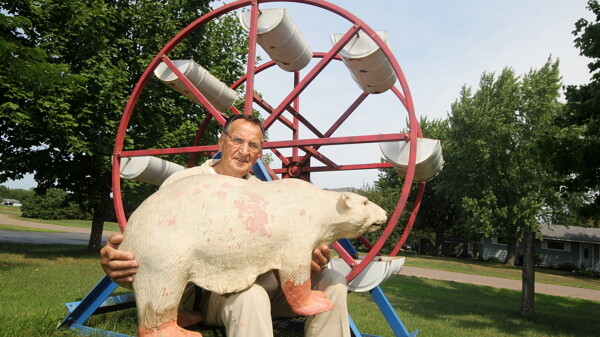The Factory
former Uniroyal employee completes eighth book on bygone tire plant
Ken Szymanski, photos by Andrea Paulseth |

Uniroyal before the closing of its Eau Claire factory. Gillette’s slogan was
“The Bear for Wear” – the bear was from Mr. Gillette’s office.)
After compiling eight books on the history of the Uniroyal tire factory, Jack Zais isn’t afraid to be blunt about his passion. “Most people would consider it a waste of time,” the former Uniroyal employee said in a recent phone interview.
Waste of time? What? Things like compiling a data base of everyone who has ever worked at the former Eau Claire tire factory? Ever? “Right now I’m at 17,474,” Zais says. Estimating the total will be slightly over 19,000, he admits that he’ll probably never get them all.
“The only way to do this is turning over every leaf possible. And the more I get into it, the more stuff pops up.” – Jack Zais, on his sprawling histories of Uniroyal
To get the 17,474 that he has so far, Zais gathered seniority lists, paged through the entire city directory—page by page, through the decades—scanning for names that had the plant listed as their employer, read the obituaries of every Leader-Telegram since 1917…and scanned the rest of every issue, as well, for Uniroyal-related news.
To complicate matters, two newspapers existed in Eau Claire for many years, so Zais had to order the microfilm for The Daily Telegram all the way from Madison. He still checks the Leader-Telegram obituaries daily to see if there’s a worker he missed.
And that’s just for the master list; his eight books have also required detective-like tenacity.
“I don’t think anyone out there has any idea how much time I put into this,” the 73-year-old says. He borrowed roughly 170 boxes of Uniroyal-related documents from the Wisconsin Historical Society and he sifted through every one. Then there’s the copy costs and labor. Zais estimates he’s photocopied four filing cabinets worth of material.
“It’s not a money-making proposition,” Zais says of his eight books on the plant’s history. “At best, I hope to recoup 10% of my costs, which is okay with me. It’s become my hobby. If I wasn’t doing this, I’d be exploring some other kind of history. I’m retired, so I gotta do something…”
Zais, who worked at Uniroyal from 1967-1992, predicts that by the end he’ll have 15 books. He’s currently working on one which covers all the main events in the plant’s history. “My primary objective is to make the most complete history of a major manufacturing facility that’s ever been done,” he says of his series.
Don’t bet against this guy; if he was going to give up, he would’ve done so long ago. Instead, he methodically plows forward, document after document. “The only way to do this is turning over every leaf possible,” he says. “And the more I get into it, the more stuff pops up.”
For example, his latest book, Diaries of Tire Plant Sisters, released in April, is a condensed version of a series of journals he came across that, if stacked, would reach 15 feet high. Zais read through every one and edited them into a book—a giant tangent in his research. “This is what happens when you keep turning up leaves,” he says.
Not everyone is interested in reading decades-old diary entries from plant workers or old Uniroyal newsletters, and to Zais, that’s understandable. “There’s not a big market for my books,” he says. “The buying public is limited to people who worked there…and maybe their children. It’s sad that I couldn’t have started this book 20 years ago. A lot of people who would’ve wanted them have passed away.”
It’s easy to imagine how the time-swallowing, singled-minded pursuit of his goal could drive a marriage to the brink. Not so in this case. “My wife loves it,” Zais says. “It keeps me out of her hair. She’s very supportive. She likes to do things like shop, so it works out.” He pauses, then drives it home: “I don’t like to shop.”
He’d rather be microfiching.
Seven of Zais’s books are available for sale at The Local Store. The Local Store also has a comprehensive index that includes names of former Uniroyal workers so potential readers can locate the book(s) in which certain people appear.


















